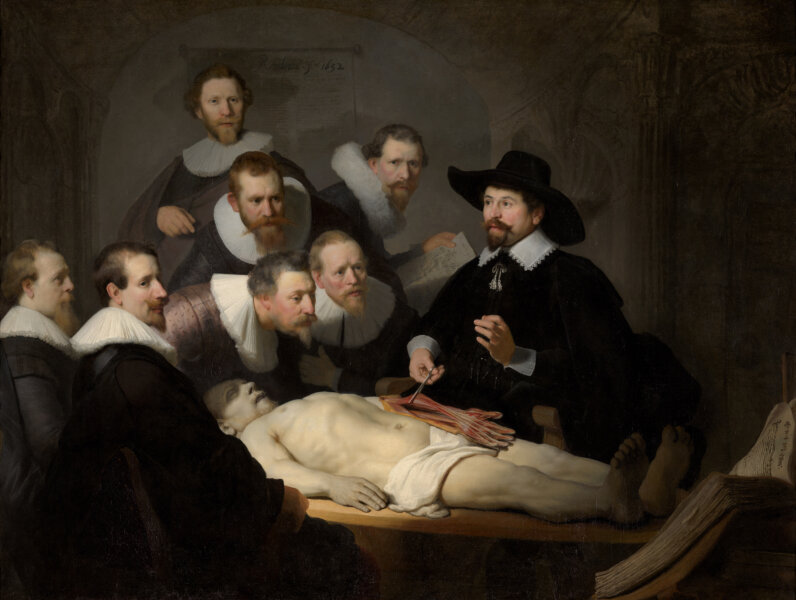Roger Buck, the author of a pair of charming books featuring a character called “The Gentle Traditionalist” (see here, here, and here), runs a YouTube channel on which may be found a (to my mind) classic episode called “(Catholic) Nectar in a Sieve.” He uses the metaphor of a sieve to explain how it is that even a valid Mass could nevertheless be an ineffective one when it comes to holding the Faith and transmitting it intact. A bad liturgy is not necessarily one in which nothing happens; it is one in which what happens is quickly lost through many holes, leaving behind a viscous residue indicating that something has passed through, but one is not quite certain what it was, or where it has gone.
In The Gentle Traditionalist Returns, Buck spells out the analogy in the following passage:
Didn’t the Church teach that the Body and Blood of Christ were truly present in the new Mass? Wasn’t it a contradiction, then, to consider the old Mass objectively superior to the new?
But Anna responded with an unusual analogy. She likened the new vernacular liturgy to a sieve. This strange image reconciled two apparently conflicting claims. For, on the one hand, the Church maintained that Christ was equally present in both Masses. Anna accepted that. But, on the other hand, the New Mass clearly lacked something. That was plain to her. Heck, it was even plain to me! People behaved differently at the new Mass. Their attention wandered all over the place. That was perfectly clear from the few times I went to it. Even the priests sometimes appeared absent-minded and sloppy, at least by comparison to the palpable reverence at the old Mass.
Anna’s analogy of the sieve resolved this tension between the two Masses. Yes, Jesus Christ became fully present in every valid Mass, new or old. But the traditional Mass provided something further, a crucial addition: a container that aided and HELD His Presence. That container was created through the sacred language of ecclesiastical Latin and the rubrics, prayers, and gestures omitted in the new Mass. The fact that the Tridentine liturgy instilled reverence, naturally directing people’s attention to the Mystery, amplified its effect. That old container was missing in the new Mass, replaced by something else—something that did not hold or facilitate the proper attention, piety, and receptivity to the Mystery at the Altar. Something that leaked like a sieve. All the omissions acted as HOLES. That was why the new Mass often, if not always, degenerated into a slovenly affair. (8–9)
I do recommend watching the video in which Roger conversationally develops this analogy, because his way of explaining it is indeed gentle, like the hero of his stories, and what he says can be helpful (and non-threatening) to those who are wrestling for the first time with the enormous differences between the traditional and modern rites in the Catholic Church (and thanks to Pope Francis’s unstinting global efforts to advertise the existence of the TLM and of communities dedicated to it, every week brings newcomers curious to know what all the fuss is about).
Other metaphors come to mind. I’ve often thought in terms of evaporation. The sacred mysteries will “evaporate” in our midst, they will disappear into thin air, either because we are not made to be consciously attentive to them by the way in which the liturgy goes about its work, or, worse, because our attention is drawn to that which is opposed to them in some way.
Or we might compare the difference of rites to the difference between crystal-clear reception of a radio station and a weak signal—as when you’re driving and your favorite classical station slowly gets invaded by a rock station or a sports announcer and, with a fatalistic sense of the inevitable progress of vulgarity, you finally have to turn it off. Regardless of taste in music, it’s disturbing and annoying to hear two incompatible stations mixed together. This is how it too often is at the Novus Ordo: the divine radio station is still broadcasting a divine message, and if you have the right receiver, you can pick it up. But the human station—the liturgy as a “work of human hands,” in Fr. Cekada’s term—is transmitting a conflicting pop or sports signal that interferes with the other.
Way back in 2011, Michael A. Beauregard wrote an article in New Oxford Review called “At Mass, Actions Speak Louder Than Words.” (It’s on their website, behind a paywall.) As a teacher of religion classes in a school he describes as “unwaveringly faithful to the Magisterium,” he noticed a disturbing phenomenon:
Year after year I am surprised by what my students know—and do not know—at the beginning of their sixth-grade year. Students are typically baffled and sometimes even stunned to learn that the Blessed Sacrament is Christ physically present in His body, blood, soul, and divinity, and not just in a spiritual or symbolic sense. More often than not, these students have incorrectly acquired the notion that the Holy Sacrifice of the Mass is just a Communion service memorializing the Last Supper with the priest acting as presider. They are fascinated to learn about the sacrificial aspects of the Mass and the priesthood, and the tremendous graces received from the Mass. Why are all these students, who have no less than five years of solid catechetical training, entering the sixth grade with an almost Protestant view of Catholic liturgy and the sacraments?
One might question the content, quality, and overall effectiveness of the religion program. But after years of observing, monitoring, and, most importantly, probing the students, I have come to a clear assessment of this peculiar situation. Irrespective of what is being taught, if the Mass and liturgies do not reflect the realities and truths of our Catholic faith, the teachings of the Church will be taught in vain. It is of the utmost importance that the Holy Mass model and emphasize what we want our students (and adults) to understand and embrace. The rubrics, gestures, and symbols that are employed serve a fundamental and very useful purpose in that they reveal and give witness to the faith we profess.
This, I would submit, is just another way of making Roger Buck’s point.
It doesn’t matter how many great homilies one hears about the awesome mystery of the Holy Eucharist. If the message is then contradicted by an informal ars celebrandi and an approach on the part of the laity to the church building, the altar, or the sanctuary that is lacking in deep reverence, no one will ever believe the words. Why should they? The words are literally useless, ineffectual, water off a duck’s back. This is the problem that conservative Catholics have still not fully come to grips with: it is not enough to have a sound papally-approved Catechism (well, at least before popes start introducing error into it) or solid parochial/diocesan catechesis. If the liturgy itself is lacking in words and actions that manifestly show what we believe without attenuation or embarrassment, the faith of the people will always be lacking.
Rembrandt’s painting of the anatomy lesson suggests another (related) metaphor. Liturgy that is totally “visible,” on display, with nothing veiled to the sight or hearing, nothing remote or inaccessible, nothing “off limits” to the laity, is like a cadaver dissected in a medical arena. The mystery of life requires clothing, modesty, privacy, a certain hiddenness: all that is gone in this demonstration class.

When lay people can walk right into the sanctuary, dressed as laypeople, how does this area remain an actual sign of what its name signifies—the holy place? It has been profaned, annexed to the empire of the everyday and the common, as if we have no need of transformation during our earthly pilgrimage; as if we have already arrived at our goal: how easy it is to achieve heaven! Even more are these errors reinforced when laity can go right up to the tabernacle and handle the very Body of God! This, all by itself, shows that the priest has been reduced to a transsubstantiating machine, a sort of sacramental chatbot; he is not by any means a person set aside for God in a holy state such that he alone (except in a case of genuine emergency) is permitted to approach and touch the holy things with his anointed hands.
Curiously, the by-now ubiquitous way of doing things in parishes makes the sacred Chrism appear holier than the very Lord of all holiness, inasmuch as lay people are never allowed to use this chrism (say, in a hospital visit), whereas lay people routinely handle the Most Holy Eucharist as if it were tokens or chips. Moreover, the Chrism is usually locked away in a cabinet to which only one or two have access, whereas it seems every Betty, Jane, and Sue has access to the tabernacle. The cognitive dissonance is massive. It is precisely such as to undermine any coherent faith in a sixth-grader.
Could we not compare this situation to the sexual union of man and woman? If people have free and easy access to it—without courtship, without friendship, without vowed lifelong commitment—it ceases to be a beautiful and mysterious expression of heightened personal love and becomes something like exercising at the gym and eating an exceptional bar of chocolate at the same time. In other words, mundane and eventually tiresome, leading to restlessness, wandering thoughts and eyes, infidelity, divorce, and an ever more desperate search for thrills, or at least for a momentary liberation from the burden of boredom.
It is no wonder that idolatry is compared in Scripture to fornication. Desacralization too may be compared to fornication and adultery. If anyone can enter the sanctuary and access the tabernacle, it loses its special set-apartness, its numinous quality, its accessibility only to those who have vowed their lives to its service. We see instead a symbolic ritual promiscuity.
The priest stands in persona Christi capitis. This means, therefore, in the person of Christ as the one Bridegroom of the Church. That is why traditionally there is only ever one celebrant, with all other ministers taking subordinate positions (don’t get me started on the aberration of concelebration; I am referring here to the traditional practice of solemn Mass with priest, deacon, subdeacon, and acolytes). To let another share this place of primacy in the liturgy and in the sanctuary transmits the subliminal message that the Bride has many husbands—like the Samaritan woman at the well in the Gospel of John, who has cycled through quite a roster of husbands. The modern Catholic liturgy carries on like the unconverted Samaritaness.
The faithful were spiritually raped by the top-down imposition of a pseudo-liturgy. They were abused by their pastors in what may be considered the archetype of clerical abuse: taking away the innocence of Catholics who had received the liturgy as a gift from their predecessors, indeed as a gift from God, and having a new one thrust upon them by a combination of legislative violence and pastoral seduction. The reform destroyed the expectations of and recognition of the sacred—that is, the precondition for having right faith and actual devotion. It has deprived many Latin-rite Catholics born later on of the knowledge that they once had a real, historic, regulated, and orderly hierarchical liturgy.
Thanks be to God, truly, that He has not left us orphaned of our Tradition but has maintained the practice of the Roman liturgy in a living continuity with our forefathers stretching back to antiquity. We do not have to “revive” something that was interrupted; we have merely to carry on with that which never ceased and will never cease to be celebrated—where prayer is real, unevaporated, with a strong signal, and no sieve in sight.
Image by PublicDomainPictures from Pixabay


